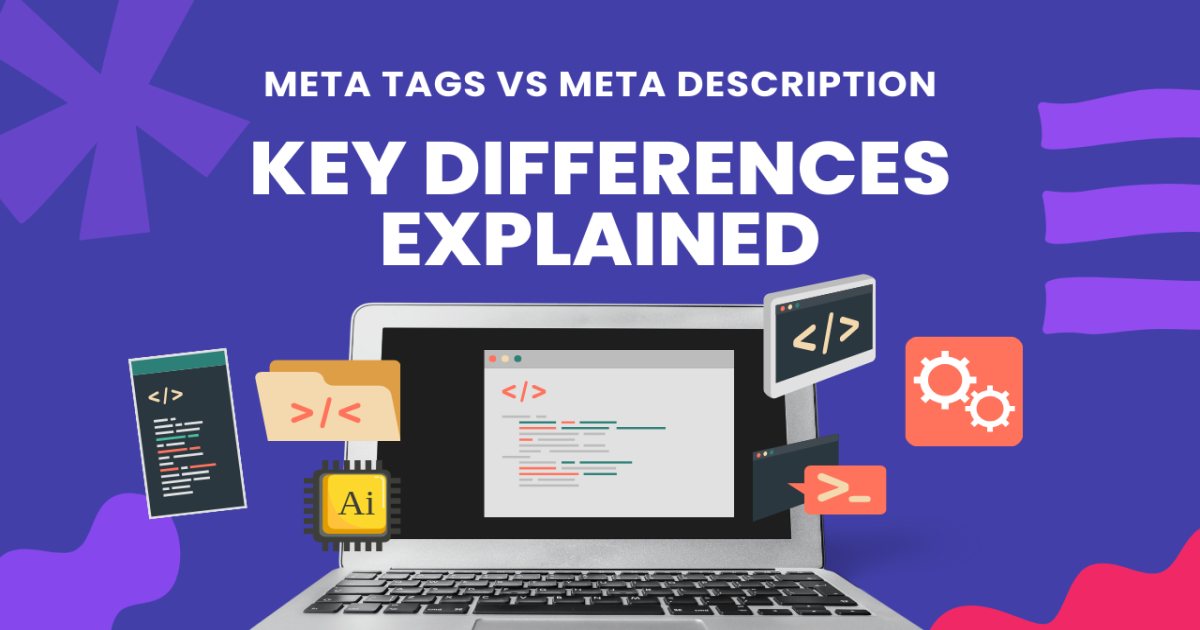Understanding the differences between meta tags and meta descriptions is crucial for effective SEO optimization. These two elements are vital in helping search engines understand the content and structure of a webpage.

A meta description is a short summary of a webpage's content, while meta tags provide additional information about the page. Both play a significant role in determining search engine visibility and ranking.
Key Takeaways
- Meta tags and meta descriptions are essential for SEO optimization.
- A meta description provides a summary of a webpage's content.
- Meta tags offer additional information about a webpage.
- Both elements impact search engine visibility and ranking.
- Understanding their differences is crucial for effective SEO.
Understanding Meta Elements in SEO
Meta elements play a crucial role in Search Engine Optimization (SEO), and understanding their functionality is essential for improving search engine visibility. These elements provide search engines with vital information about a website's content, structure, and purpose.
What Are Meta Tags?
Meta tags are HTML tags that provide search engines with metadata about a webpage. They are placed in the <head> section of the HTML document and are not visible on the webpage itself. Meta tags serve as a communication channel between the website and search engines, providing information such as character encoding, keywords, and viewport settings.
Common Types of Meta Tags
There are several types of meta tags, each serving a specific purpose. Some of the most common include:
- Robots meta tag: Instructs search engines on how to crawl and index the webpage.
- Viewport meta tag: Controls the zooming and scaling of webpages on mobile devices.
- Charset meta tag: Specifies the character encoding of the HTML document.
The following table summarizes the common types of meta tags and their functions:
| Meta Tag | Function |
|---|---|
| Robots | Instructs search engines on crawling and indexing |
| Viewport | Controls mobile device zooming and scaling |
| Charset | Specifies character encoding |
What Is a Meta Description?
A meta description is a type of meta tag that provides a brief summary of a webpage's content. It is typically displayed in search engine results pages (SERPs) below the webpage's title. A well-crafted meta description can improve click-through rates by enticing users to visit the webpage.
As noted by
"A good meta description is like a mini-advertisement for your webpage, and it should be compelling enough to persuade users to click through."
Meta Tags vs Meta Description: Key Differences
Meta tags and meta descriptions are two fundamental elements in SEO that serve distinct purposes in search engine results. While both are crucial for optimizing a webpage, they differ significantly in their functions and impacts on search engine rankings and user click-through rates.
Purpose and Function in Search Results
Meta tags provide search engines with information about a webpage's content, structure, and context, influencing how the page is crawled and indexed. They do not directly impact click-through rates but are vital for search engine understanding and ranking.
In contrast, meta descriptions are designed to entice users to click through to a webpage by providing a concise summary of the page's content. A well-crafted meta description can significantly improve click-through rates by appealing to the user's search intent.

Format and Length Requirements
Meta tags have specific formats and character limits. For instance, title tags should be under 60 characters to avoid truncation in search results. Other meta tags, like description tags, have different requirements.
Meta descriptions, on the other hand, should be between 150-160 characters. Exceeding this limit can result in truncation, potentially losing valuable information or call-to-action.
Impact on SEO and Click-Through Rates
While meta tags are crucial for SEO as they help search engines understand the content and context of a webpage, meta descriptions directly influence user behavior by enticing clicks.
A well-optimized meta description can boost click-through rates, driving more traffic to a webpage. Conversely, meta tags, though not directly influencing click-through rates, are essential for achieving higher search engine rankings.
Optimizing Meta Elements for Better Search Visibility
Optimizing meta elements is crucial for enhancing search engine visibility and driving more traffic to your website. By fine-tuning your meta tags and descriptions, you can significantly improve your website's search engine ranking and click-through rates.

Best Practices for Meta Tags
When it comes to meta tags, there are several best practices to keep in mind. First, ensure that your title tags are descriptive, unique, and include target keywords. Avoid keyword stuffing and keep your title tags concise, ideally under 60 characters. Additionally, use meta robots tags to guide search engine crawlers on how to index and follow your web pages.
Writing Effective Meta Descriptions
Crafting compelling meta descriptions is an art that requires a blend of creativity and strategy. Your meta description should entice users to click through to your website while accurately summarizing the content of the page. Include target keywords naturally, and keep your meta descriptions between 150-160 characters to avoid truncation in search engine results.
| Best Practices | Meta Tags | Meta Descriptions |
|---|---|---|
| Length | Under 60 characters | 150-160 characters |
| Keyword Use | Include target keywords | Include target keywords naturally |
| Uniqueness | Unique title tags | Unique descriptions for each page |
Common Mistakes to Avoid
When optimizing meta elements, there are several common pitfalls to avoid. Duplicate meta tags and descriptions can confuse search engines and dilute your SEO efforts. Avoid using duplicate content across multiple pages, and ensure that each page has a unique meta tag and description. Additionally, be mindful of keyword stuffing, as it can lead to penalties from search engines.
Conclusion
Understanding the differences between meta tags and meta descriptions is crucial for effective SEO optimization. By leveraging these meta elements, businesses can improve their search engine visibility, driving more traffic to their websites.
A well-crafted meta tag and meta description strategy can significantly enhance a website's online presence. By summarizing the key differences and best practices outlined in this article, readers can develop a comprehensive understanding of how to optimize their meta elements for better search engine rankings.
In summary, a thorough SEO optimization summary highlights the importance of meta tags and meta descriptions in improving search engine visibility. By applying the insights gained from this article, businesses can refine their SEO strategies, ultimately boosting their online presence and driving more targeted traffic to their websites.






